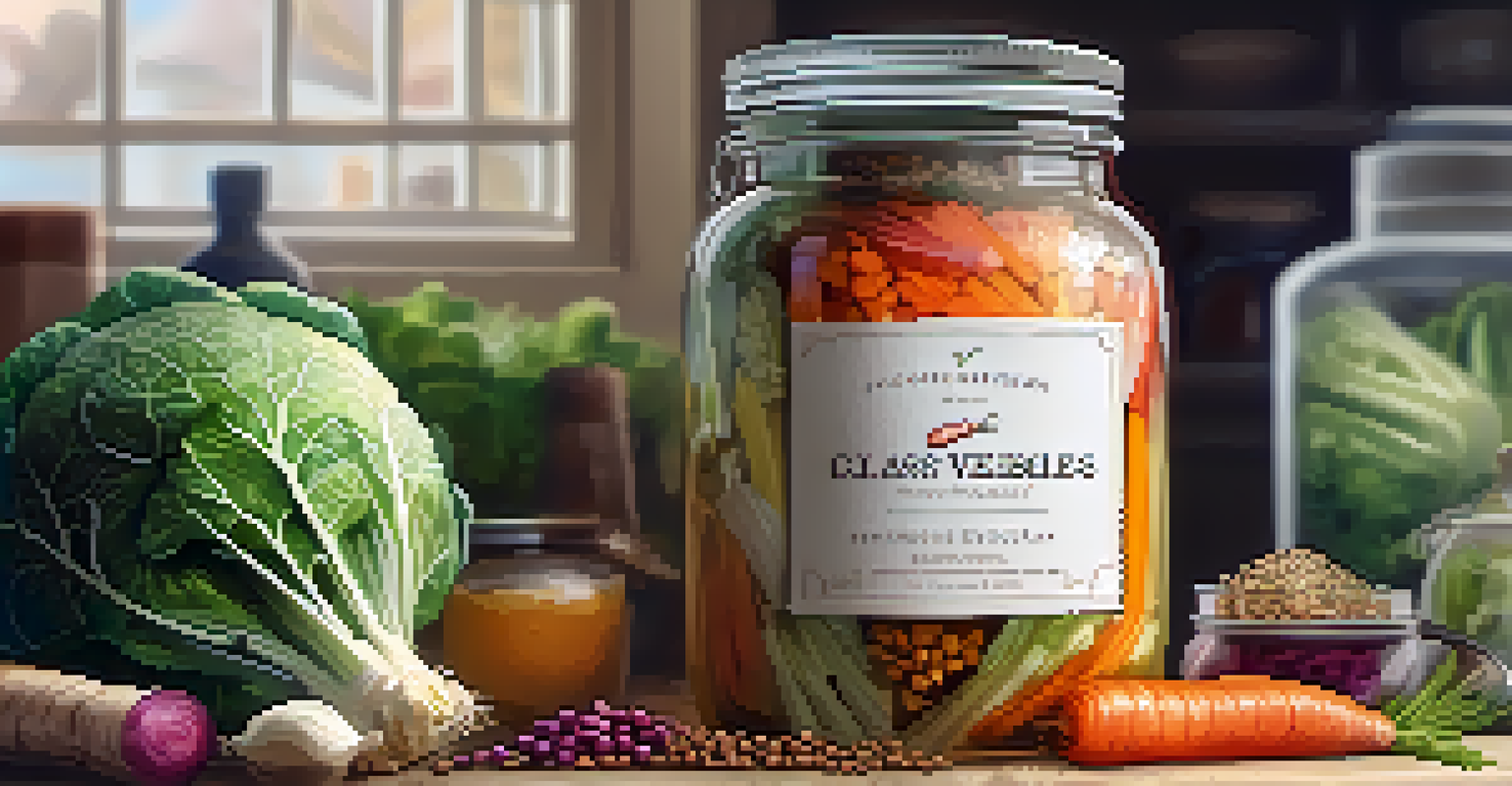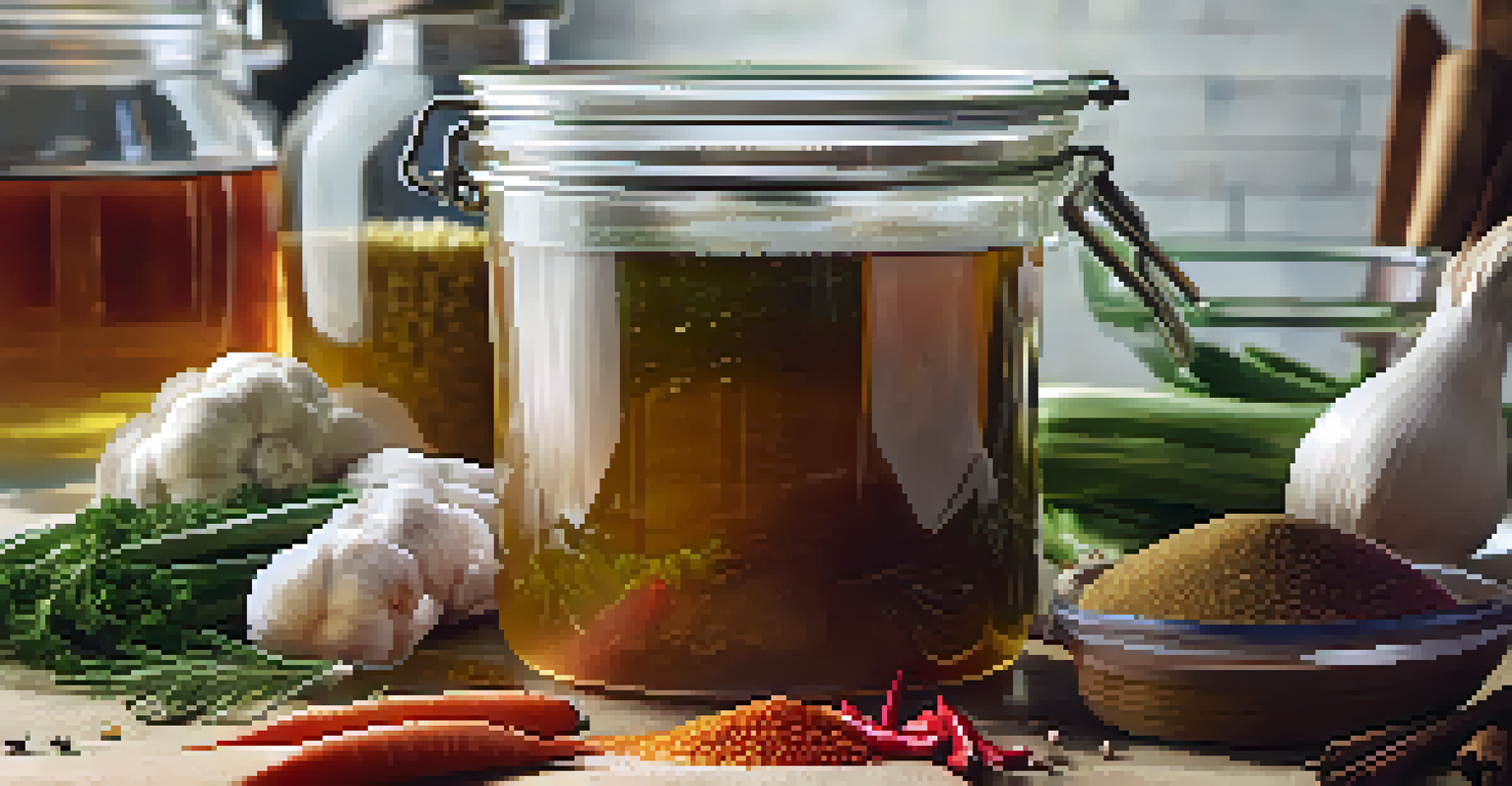Fermentation Safety: Tips for Safe Vegetable Fermentation

Understanding Fermentation: The Basics of the Process
Fermentation is a natural process where microorganisms like bacteria and yeast convert sugars into acids, gases, or alcohol. This not only preserves vegetables but also enhances their flavors and nutritional value. Imagine it as a culinary time capsule, where your veggies are transformed into tangy, probiotic-rich delights.
Fermentation is the ultimate natural preservation method, giving flavor and health benefits to our food.
The magic happens when you create an anaerobic environment, meaning there’s no oxygen present. This is crucial because unwanted bacteria thrive in oxygen, which can lead to spoilage. By keeping your vegetables submerged in brine or using fermentation weights, you can ensure that your tasty creations stay safe and delicious.
It's important to understand that not all fermentation methods are equal. While some can be done on the counter, others require cooler temperatures. Getting to know the basics of the fermentation process will help you make informed decisions and avoid pitfalls along the way.
Choosing the Right Vegetables for Fermentation
Not all vegetables are created equal when it comes to fermentation. Some, like cucumbers and cabbage, naturally lend themselves to this process due to their structure and sugar content. Think of these as the star players in your fermentation lineup, ready to shine in their tangy glory.

When selecting vegetables, look for fresh, organic options that are free from blemishes or signs of spoilage. Just like you wouldn’t bake with stale ingredients, using high-quality produce is key to achieving the best results. It’s like starting a race with a strong team; you want every member to be at their peak.
Fermentation Enhances Flavor and Value
This natural process preserves vegetables while boosting their flavors and nutritional benefits.
Additionally, consider the flavor profiles of your chosen vegetables. Mixing different types can create unique combinations and enhance taste. Just remember to keep things balanced and don’t overload your jars; fermentation needs space to work its magic!
Essential Tools for Safe Fermentation
Having the right tools can make a significant difference in your fermentation journey. Basic equipment includes jars, fermentation weights, and a good quality lid that allows gases to escape. Think of these tools as your fermentation safety net, ensuring that your process is as smooth as possible.
Good food is the foundation of genuine happiness.
Glass jars are ideal because they are non-reactive, making them perfect for acidic environments. Avoid using metal containers, as they can react with the acids produced during fermentation, potentially ruining your vegetables. It's like choosing the right vehicle for a road trip; the right jar will help you reach your tasty destination safely.
Lastly, a pH meter or pH test strips can be invaluable for monitoring acidity levels. Keeping track of the pH ensures that your fermentation is progressing safely and effectively. Just like checking the weather before a big outing, knowing your pH levels can help you avoid surprises.
Creating the Perfect Brine for Your Vegetables
The brine is a crucial component of vegetable fermentation, acting as a protective barrier against unwanted bacteria. A simple saltwater solution is often all you need, with the ratio usually being around 2-3 tablespoons of salt per quart of water. This not only helps to create the right environment for fermentation but also enhances flavor.
When making your brine, it's essential to use non-iodized salt, as iodine can inhibit fermentation. Think of this as making a potion; the right ingredients are crucial for achieving the desired outcome. Kosher or sea salt are great options that won’t interfere with your fermentation magic.
Choose Fresh Vegetables for Success
Selecting high-quality, fresh produce is essential for achieving the best fermentation results.
Once your brine is ready, ensure that your vegetables are fully submerged to prevent exposure to oxygen. This is where fermentation weights come into play. They keep your veggies under the brine, allowing for a successful fermentation process with minimal risk.
Monitoring Your Fermentation Process Carefully
Patience is key in fermentation, and monitoring your process is essential for success. Depending on the type of vegetable and environmental conditions, fermentation can take anywhere from a few days to several weeks. Consider it a waiting game, where the reward is well worth the time invested.
As your vegetables ferment, keep an eye out for bubbles and a slight change in aroma. A tangy scent is a good sign, indicating that the fermentation is progressing well. However, any off-putting smells or unusual colors could be a red flag, signaling potential spoilage.
Regularly taste your ferment to check for flavor and texture. This is the fun part! It allows you to determine when your vegetables have reached your desired level of tanginess. Remember, this is your creation, and it's all about finding that perfect balance.
Recognizing Signs of Spoilage in Fermented Vegetables
While fermentation is generally safe, it's crucial to recognize signs of spoilage. If you notice any mold on the surface, it’s a sign that something has gone awry. Mold can be fuzzy or discolored, and if you see it, it’s best to err on the side of caution and discard the entire batch.
Unpleasant odors can also indicate spoilage. If your fermented veggies smell off or rancid, it’s best to toss them. Think of your nose as your first line of defense; it often knows when something isn’t right before your eyes can catch it.
Monitor and Store for Best Results
Carefully monitoring the fermentation process and storing the finished product properly ensures optimal flavor and safety.
Lastly, be cautious of gas release and excessive bubbling. While some fizz is normal, if your jars are overflowing or emitting too much gas, it might mean that fermentation has gone into overdrive. Learning to recognize these signs will help ensure that your fermentation endeavors remain safe and enjoyable.
Storing Your Fermented Vegetables for Best Results
Once fermentation is complete, proper storage is essential to maintain the flavors and health benefits of your veggies. Transferring them to the refrigerator slows down the fermentation process, allowing you to enjoy them at your leisure. It’s like hitting the pause button on a great movie, giving you more time to savor the experience.
Store your fermented vegetables in airtight containers to keep out unwanted air and moisture. Glass jars with tight-fitting lids are ideal for this purpose. This step helps to preserve freshness and flavor, ensuring that every bite remains delicious.

Don’t forget to label your jars with the date! This way, you can track how long they’ve been stored and enjoy them within a reasonable timeframe. Most fermented vegetables can last for several months in the fridge, but it’s always best to enjoy them while they’re at their peak.